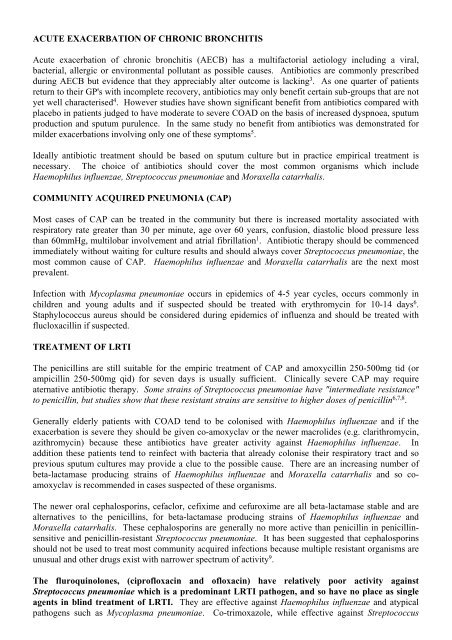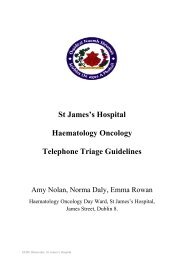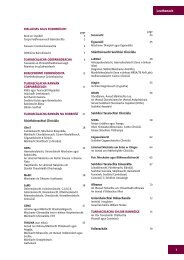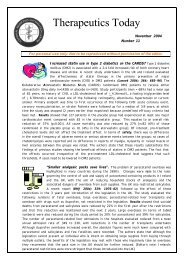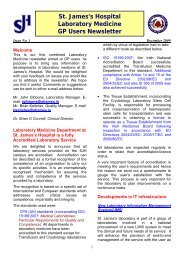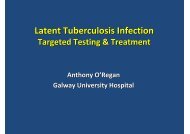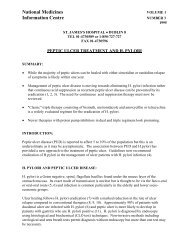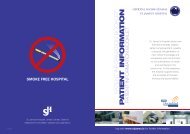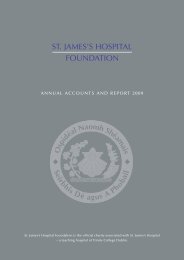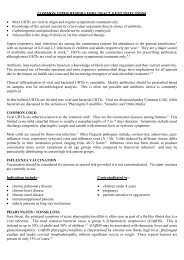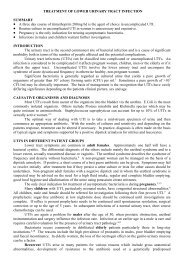TREATMENT OF LOWER RESPIRATORY TRACT INFECTION
TREATMENT OF LOWER RESPIRATORY TRACT INFECTION
TREATMENT OF LOWER RESPIRATORY TRACT INFECTION
You also want an ePaper? Increase the reach of your titles
YUMPU automatically turns print PDFs into web optimized ePapers that Google loves.
ACUTE EXACERBATION <strong>OF</strong> CHRONIC BRONCHITISAcute exacerbation of chronic bronchitis (AECB) has a multifactorial aetiology including a viral,bacterial, allergic or environmental pollutant as possible causes. Antibiotics are commonly prescribedduring AECB but evidence that they appreciably alter outcome is lacking 3 . As one quarter of patientsreturn to their GP's with incomplete recovery, antibiotics may only benefit certain sub-groups that are notyet well characterised 4 . However studies have shown significant benefit from antibiotics compared withplacebo in patients judged to have moderate to severe COAD on the basis of increased dyspnoea, sputumproduction and sputum purulence. In the same study no benefit from antibiotics was demonstrated formilder exacerbations involving only one of these symptoms 5 .Ideally antibiotic treatment should be based on sputum culture but in practice empirical treatment isnecessary. The choice of antibiotics should cover the most common organisms which includeHaemophilus influenzae, Streptococcus pneumoniae and Moraxella catarrhalis.COMMUNITY ACQUIRED PNEUMONIA (CAP)Most cases of CAP can be treated in the community but there is increased mortality associated withrespiratory rate greater than 30 per minute, age over 60 years, confusion, diastolic blood pressure lessthan 60mmHg, multilobar involvement and atrial fibrillation 1 . Antibiotic therapy should be commencedimmediately without waiting for culture results and should always cover Streptococcus pneumoniae, themost common cause of CAP. Haemophilus influenzae and Moraxella catarrhalis are the next mostprevalent.Infection with Mycoplasma pneumoniae occurs in epidemics of 4-5 year cycles, occurs commonly inchildren and young adults and if suspected should be treated with erythromycin for 10-14 days 6 .Staphylococcus aureus should be considered during epidemics of influenza and should be treated withflucloxacillin if suspected.<strong>TREATMENT</strong> <strong>OF</strong> LRTIThe penicillins are still suitable for the empiric treatment of CAP and amoxycillin 250-500mg tid (orampicillin 250-500mg qid) for seven days is usually sufficient. Clinically severe CAP may requireaternative antibiotic therapy. Some strains of Streptococcus pneumoniae have "intermediate resistance"to penicillin, but studies show that these resistant strains are sensitive to higher doses of penicillin 6,7,8 .Generally elderly patients with COAD tend to be colonised with Haemophilus influenzae and if theexacerbation is severe they should be given co-amoxyclav or the newer macrolides (e.g. clarithromycin,azithromycin) because these antibiotics have greater activity against Haemophilus influenzae. Inaddition these patients tend to reinfect with bacteria that already colonise their respiratory tract and soprevious sputum cultures may provide a clue to the possible cause. There are an increasing number ofbeta-lactamase producing strains of Haemophilus influenzae and Moraxella catarrhalis and so coamoxyclavis recommended in cases suspected of these organisms.The newer oral cephalosporins, cefaclor, cefixime and cefuroxime are all beta-lactamase stable and arealternatives to the penicillins, for beta-lactamase producing strains of Haemophilus influenzae andMoraxella catarrhalis. These cephalosporins are generally no more active than penicillin in penicillinsensitiveand penicillin-resistant Streptococcus pneumoniae. It has been suggested that cephalosporinsshould not be used to treat most community acquired infections because multiple resistant organisms areunusual and other drugs exist with narrower spectrum of activity 9 .The fluroquinolones, (ciprofloxacin and ofloxacin) have relatively poor activity againstStreptococcus pneumoniae which is a predominant LRTI pathogen, and so have no place as singleagents in blind treatment of LRTI. They are effective against Haemophilus influenzae and atypicalpathogens such as Mycoplasma pneumoniae. Co-trimoxazole, while effective against Streptococcus


